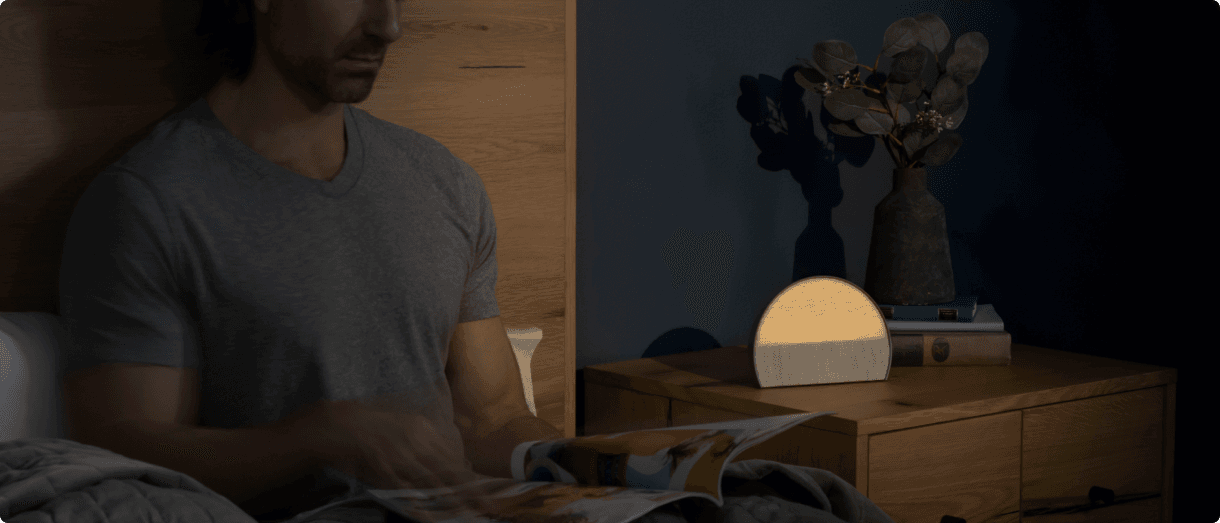How To Use Your Hatch Light To Optimize Your Sleep and Wakefulness
Whether you’re revving up for a busy day or winding down before bed, your circadian rhythm is at work, telling your brain what time it is so your body can respond accordingly. Think of your circadian rhythm as your internal clock — the driving force behind all the important physiological processes that impact your behavior.
Many factors help your brain distinguish what time it is, but light sends an especially powerful message, says Jade Wu, Ph.D., a behavioral sleep psychologist and Hatch sleep expert. Exposure to sunlight helps wake you up in the morning by suppressing the release of sleep-inducing melatonin — then, light dwindles through the day, and your body starts secreting it again.
Remember learning the acronym “ROY G BIV” in science class? It’s a helpful device for remembering the order of the colors in the rainbow -- red, orange, yellow, green, blue, indigo, violet. Visible light from the sun is a spectrum of colors, and each one has a unique effect on your body — and you can use them to optimize your circadian rhythm. Below, learn more about how the light features on Hatch devices -- like the adult Restore or the Rest+ 2nd Gen for baby and kids -- can help you and your family form routines that support your well-being.

Morning
In the spectrum of visible light, short wavelength colors impact your circadian rhythm the most. Blue and green light, and broad-spectrum white light that encompasses all the colors, suppress melatonin secretion. When melatonin levels dip, you may feel less tired and more energized. That’s why experts typically encourage shutting off blue light-emitting electronic devices before bed.
If your goal is an energy boost in the morning, you can use short-wavelength light on your Hatch device to your advantage while you get ready. For some people, Dr. Wu says blue or green light can be too stimulating; white is a good option for a gentler boost. Either way: A brighter light setting is a good choice for an energized morning.
A tip from Hatch: Pair your Morning Moment energizing sounds with a bright white light to set your tone for the day.
Afternoon
In the afternoon, you may need an energy boost to help you focus on work or school. Too much blue light might be too potently energizing, leading to unwanted jitters, so Dr. Wu recommends setting your Hatch on white light instead — especially if you can’t get outside for some real sunlight. Try slowly dimming the light throughout the afternoon to help your body transition to the PM.
White light can be a helpful context setter for your circadian rhythm in the afternoon. If you’re around your Hatch device for most of the day -- your bedroom is also your office or you live in a dorm room -- Dr. Wu says you can use the Hatch to help differentiate between night and day.
A tip from Hatch: Set a long duration during your Unwind routine to help your mind and body cue towards bed as the afternoon progresses. Pair it with Unwind sounds to help create a relaxing mood.
Evening
Longer wavelengths, such as red, orange, and yellow, don’t affect your circadian rhythm directly like short wavelengths. “Rather than making you feel tired, these colors just allow the melatonin to come through,” says Dr. Wu. That’s why in the late afternoon and early evening, Dr. Wu recommends choosing dimmer, warmer light — think red and orange — that helps your body shift gears from wakefulness to rest.
There’s also a psychological component to setting a cozy vibe as you relax at night. “I sometimes set the orange light with a fire crackling sound, which feels soothing like a campfire,” says Dr. Wu.

Bedtime
As a rule, the closer you get to bedtime, the dimmer your lights should be. Total darkness is always best for sleep when possible because any light exposure can interfere with deep rest (your body can perceive light even when your eyes are closed). Rather than using light for sleep, Dr. Wu suggests choosing a soothing sound you like on your Hatch.
A tip from Hatch: in your settings, you can customize your clock to automatically dim during specific periods of time. If you want to know the time during that period, tap your Restore to quickly light up the time, without turning on a light.
But if you need a nightlight, opt for long wavelengths, such as red or orange. “The most important thing is to not use any blue or white light in the evening,” Dr. Wu says.